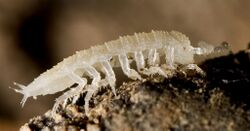Biology:Mesoniscus
| Mesoniscus | |
|---|---|

| |
| M. graniger | |
| Scientific classification | |
| Kingdom: | |
| Phylum: | |
| Subphylum: | |
| Class: | |
| Order: | |
| Suborder: | |
| Section: | Microcheta Schmalfuss, 1989
|
| Family: | Mesoniscidae Verhoeff, 1908
|
| Genus: | Mesoniscus Carl, 1906
|
| Species | |
| |
Mesoniscus is a genus of woodlice, placed in its own family, Mesoniscidae, and section, Microcheta. It contains two species – Mesoniscus alpicolus and Mesoniscus graniger – that live in Central and Eastern Europe, mostly in and around caves.
Distribution
Mesoniscus is restricted to Central Europe and the Balkan Peninsula; the ranges of its two species do not overlap.[1]
M. alpicolus is found in Lombardy and the Northern Calcareous Alps.[1] In Austria, its range extends from the Karwendel near Innsbruck to the eastern edge of the Wienerwald, although it is also found in isolated pockets of Triassic and Silurian–Devonian limestone in Styria.[2]
M. graniger has a wider distribution than its congener; it is found in much of the Carpathians, including the Bihor and Banat mountains, and in the Dinaric Alps and Julian Alps.[1] It is also found in the Caves of Aggtelek Karst in Hungary.[3]
Taxonomy
The first description of a woodlouse now in the genus Mesoniscus was in 1858, when Camill Heller described "Titanethes alpicolus" in 1858.[4] This was followed in 1865 by the description by János Frivaldszky (Ján Frivaldský) of the subspecies "Titanethes alpicolus graniger".[4]
Mesoniscus is the only genus in the family Mesoniscidae,[5] and is considered so distinct from other woodlice that the family is placed in a separate section, named Microcheta.[5][6]
Ecology
Mesoniscus species lack the pleopodal lungs found in many other woodlice, and are restricted to damp environments.[7]
References
- ↑ Jump up to: 1.0 1.1 1.2 Andrei Giurginca (2001). "The spreading of the genus Mesoniscus in the Romanian Carpathians". Travaux de l'Institut Spéleologique "Émile Racovitza" 39–40: 11–22. http://www.speotravaux.iser.ro/00-01/art02.pdf.[yes|permanent dead link|dead link}}]
- ↑ Hans Strouhal (1951). "Die österreichischen Landisopoden, ihre Herkunft und ihre Beziehung zu den Nachbarländern" (in de). Verhandlungen der Zoologisch-botanischen Gesellschaft Wien 92: 116–142. http://www.landesmuseum.at/pdf_frei_remote/VZBG_92_0116-0142.pdf.
- ↑ Ferenc Vilisics; Antal Nagy; Péter Sólymos; Roland Farkas; Zita Kemencei; Barna Páll-Gergely; Máté Kisfali; Elisabeth Hornung (2008). "Data on the terrestrial Isopoda fauna of the Alsó-hegy, Aggtelek National Park, Hungary". Folia Faunistica Slovaca 13 (4): 19–22. http://zoology.fns.uniba.sk/ffs/pdf/FFS-13-04-Vilisics-et-al-2008.pdf.
- ↑ Jump up to: 4.0 4.1 H.-E. Gruner & I. Tabacaru (1962). "Revision der Familie Mesoniscidae Verhoeff, 1908 (Isopoda, Oniscoidea)". Crustaceana 6 (1): 15–34. doi:10.1163/156854063X00318.
- ↑ Jump up to: 5.0 5.1 Helmut Schmalfuss (2003). "World catalog of terrestrial isopods (Isopoda: Oniscidea) – revised and updated version". Stuttgarter Beiträge zur Naturkunde, Serie A 654: 341 pp. http://www.oniscidea-catalog.naturkundemuseum-bw.de/Cat_terr_isop.pdf.
- ↑ Alice Michel-Salzat; Didier Bouchon (2000). "Phylogenetic analysis of mitochondrial LSU rRNA in oniscids". Comptes Rendus de l'Académie des Sciences, Série III 323 (9): 827–837. doi:10.1016/S0764-4469(00)01221-X. PMID 11072627.
- ↑ Christian Schmidt; Johann Wolfgang Wägele (2001). "Morphology and evolution of respiratory structures in the pleopod exopodites of terrestrial Isopoda (Crustacea, Isopoda, Oniscidea)". Acta Zoologica 82 (4): 315–330. doi:10.1046/j.1463-6395.2001.00092.x.
External links
Wikidata ☰ Q4352652 entry
 |


